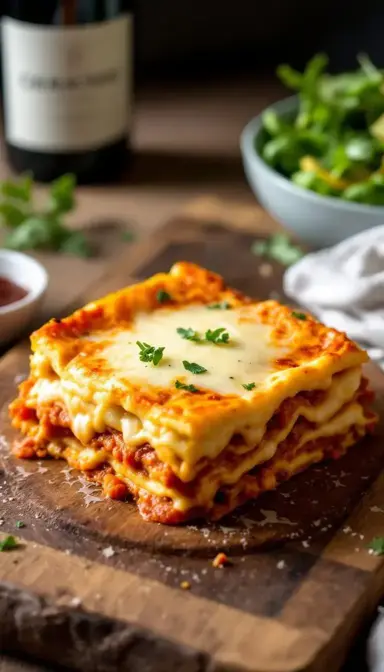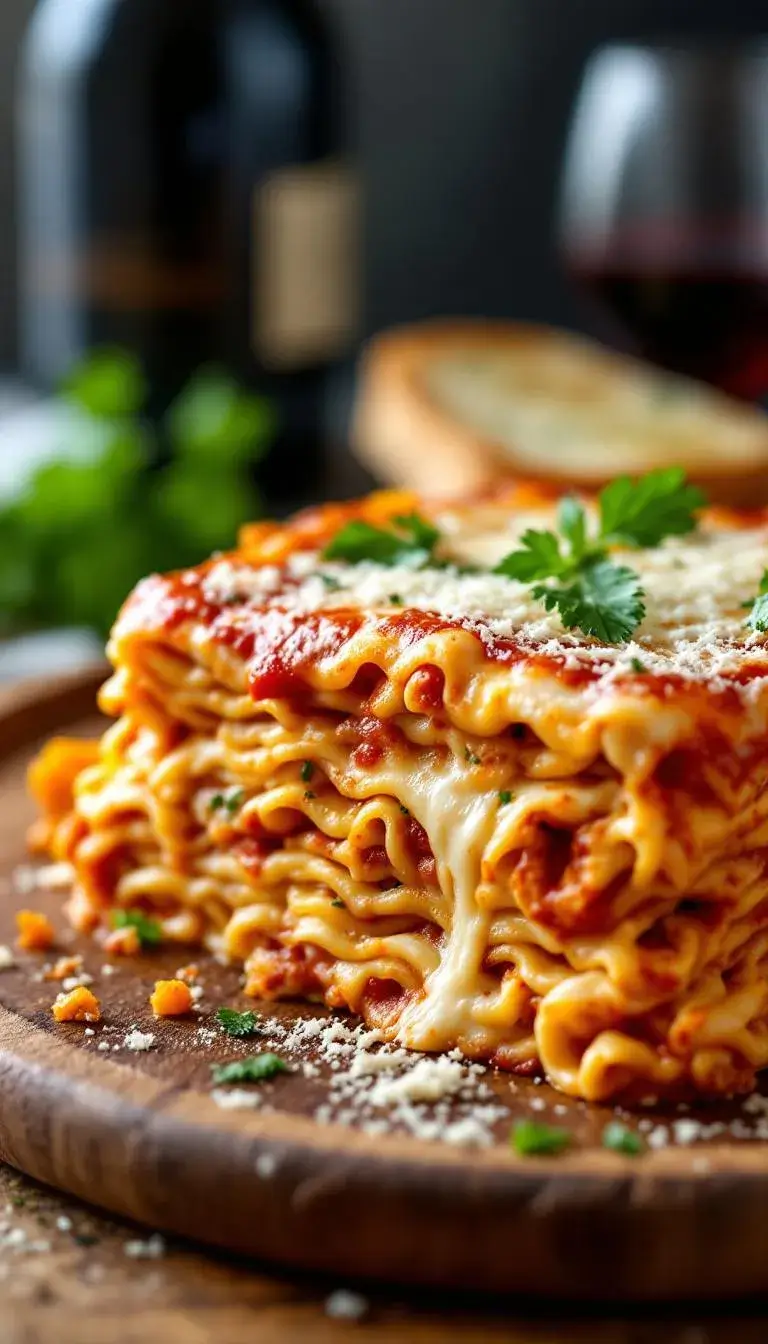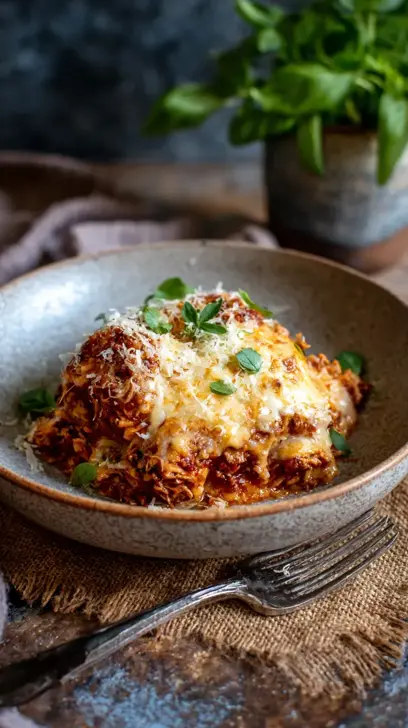Let me tell you about the first time I discovered polenta pasticciata. I was wandering through a tiny trattoria in Milan, desperately craving lasagna but needing to avoid gluten. What arrived at my table changed my culinary life forever – layers of Creamy Polenta, rich meat sauce, and bubbling cheese that hugged my soul like a warm Italian grandmother. Today, I’m sharing my perfected version of this Northern Italian masterpiece that proves gluten-free doesn’t mean flavor-free.
Why This Recipe Works
This isn’t just a gluten-free substitute – it’s a celebration of textures and flavors that stands proudly on its own. The polenta becomes this incredible canvas that soaks up all the deliciousness while maintaining its satisfying bite. And that moment when your fork breaks through the crispy cheese crust into the creamy layers beneath? Pure magic.
The Story Behind the Dish
Polenta pasticciata translates to “messy polenta,” and there’s something beautifully honest about that name. This was peasant food at its finest – a way for resourceful Italian cooks to transform humble leftovers into something extraordinary. I love how it takes simple ingredients and elevates them through layering and baking, much like how my nonna would turn yesterday’s bread into today’s bread pudding.
Essential Ingredients & Tools
Ingredients for the Polenta (Your Gluten-Free Noodle Alternative)
- 4 cups water or broth (I always use broth – it’s like giving your polenta a flavor head start)
- 1 cup coarse polenta (the stone-ground variety has this wonderful texture that’ll make you forget about pasta)
- 1 tsp salt
- 2 tbsp butter (because everything’s better with butter)
Ingredients for the Ragù (The Heart of the Dish)
- 1 lb ground beef (or go wild with mushrooms for a vegetarian twist)
- 1 onion, diced (the unsung hero of so many great dishes)
- 2 garlic cloves, minced (measure with your heart, I always say)
- 1 carrot, grated (for sweetness and color)
- 1 celery stalk, diced (the flavor backbone)
- 1 (28 oz) can crushed tomatoes (summer in a can)
- 1 tsp dried oregano (that unmistakable Italian aroma)
Ingredients for the Béchamel (The Velvety Glue)
- 2 cups whole milk (or your favorite non-dairy alternative)
- 3 tbsp butter
- 3 tbsp gluten-free flour (or regular flour if gluten isn’t an issue)
- ¼ tsp nutmeg (just a whisper – it makes all the difference)
Additional Layers
- 1 ½ cups shredded mozzarella (because what’s life without stretchy cheese?)
- ½ cup grated Parmesan (the salty, nutty finishing touch)
Tools
- 9×13-inch baking dish (or any similar casserole dish)
- Heavy-bottomed pot (a Dutch oven works great)
- Whisk (a fork can work in a pinch)
The Step-by-Step Magic
Crafting the Perfect Polenta Base
- Start by bringing your 4 cups liquid to a vigorous boil in a heavy pot – I like to imagine it’s a tiny hot spring bubbling away.
- Slowly rain in the 1 cup polenta while whisking constantly to avoid lumps (we’re going for smooth, not lumpy like my first attempts at this dish).
- Reduce to a gentle simmer and stir frequently – this is where patience pays off. After about 20 minutes, you’ll notice the polenta starts to pull away from the sides of the pot like it’s ready for its next adventure.
- That’s when you stir in the 2 tbsp butter, then spread it out to cool.
Pro tip from my kitchen disasters: Let that polenta cool completely before layering. Warm polenta turns into a sticky mess that’ll make your layers slide apart like a Jenga tower. The cooling process (called retrogradation) allows the starches to firm up properly.
Building Flavor with Ragù
- In your favorite skillet, sauté the 1 onion, 2 garlic cloves, 1 carrot, and 1 celery stalk until they soften and smell like heaven.
- Add the 1 lb ground beef, breaking it up like you’re solving a delicious puzzle.
- When the meat is browned, stir in the 28 oz can crushed tomatoes and 1 tsp oregano, then let it simmer until thickened.
Key insight: This slow reduction concentrates all the flavors into something extraordinary. A watery ragù is the enemy here – cook it until you can drag a spoon through and see the bottom of the pan briefly before the sauce flows back.
Mastering the Béchamel
- Melt 3 tbsp butter in a saucepan and whisk in the 3 tbsp flour until it smells toasty and nutty (about 1-2 minutes – this cooks out the raw flour taste).
- Gradually add the 2 cups milk, whisking constantly like you’re conducting a creamy symphony.
- Cook until it coats the back of a spoon – that perfect consistency where it clings but still flows.
Chef’s secret: A ¼ tsp nutmeg at the end adds this subtle warmth that’ll make people wonder what your secret is. If your sauce gets too thick, just whisk in a splash more milk.
Assembling Your Masterpiece
- Slice your cooled polenta into rectangles – think of them as your gluten-free noodles.
- In a 9×13 baking dish, start with a thin layer of béchamel (this prevents sticking and adds creaminess).
- Then layer polenta, ragù, béchamel, and 1 ½ cups mozzarella and ½ cup Parmesan cheeses, repeating until you’ve used everything up.
Critical step: Gently press down each layer – this isn’t just busywork, it ensures every bite has perfect harmony of textures by eliminating air pockets that can cause uneven baking.
The Grand Finale: Baking
Bake at 375°F for 30-35 minutes until golden and bubbly – that moment when the cheese forms these beautiful brown spots that promise crunch and flavor.
Resting rule: Let it rest for 10 minutes before slicing (I know it’s hard to wait, but this prevents a polenta landslide on your plate as the fats solidify slightly).
Chef’s Secrets for Success
Polenta Texture is Everything
Your polenta should be firm enough to slice but still creamy – think of the consistency of playdough that’s been worked just right. Too stiff? Add a splash of warm liquid. Too soft? Let it cool longer.
Ragù Reduction Matters
A watery ragù will make your layers slip and slide. Cook it down until you can drag a spoon through it and see the bottom of the pan for a second before the sauce flows back. For extra depth, deglaze the pan with 2 tbsp red wine before adding tomatoes.
Béchamel Balance
Your sauce should pour slowly but steadily – like warm honey. If it’s too thick, whisk in more milk. Too thin? Cook it a bit longer.
Perfect Pairings
Complementary Dishes
Arugula Salad with Lemon Vinaigrette
The peppery greens and acidic dressing cut through the richness beautifully. For extra crunch, add shaved fennel or toasted pine nuts.
Roasted Garlic Green Beans
Sweet, caramelized garlic balances the savory layers perfectly. Roast at 400°F until slightly blistered for maximum flavor.
Drinks
Chianti Classico
This medium-bodied red wine’s tannins stand up to the ragù beautifully, while its cherry notes complement the tomatoes.
Sparkling Water with Citrus
A refreshing palate cleanser between bites. Add orange slices and a sprig of rosemary for a fancy touch.
Something Sweet
Dark Chocolate Espresso Truffles
A bittersweet finish contrasts wonderfully with the dish’s creaminess. Serve with a shot of grappa for an authentic Italian experience.
Lemon Olive Oil Cake
The bright citrus flavor provides the perfect ending to this rich meal. Drizzle with honey for a touch of natural sweetness.
Storage & Freshness
This dish is even better the next day as the flavors meld together. Store leftovers in the fridge for up to 3 days, or freeze portions for those nights when only comfort food will do.
Freezing tip: Wrap individual portions in parchment paper, then foil. They’ll keep for up to 3 months. Reheat from frozen at 375°F for 40-45 minutes, covering with foil halfway to prevent over-browning.
Make It Your Own
The beauty of this dish is its versatility:
- Vegetarian version: Swap beef for 1 lb cremini mushrooms and add 1 tsp soy sauce for umami depth
- Dairy-free: Use almond milk in the béchamel and nutritional yeast instead of Parmesan
- Spicy twist: Add 1 tsp red pepper flakes to the ragù for some heat
FAQs
Can I use instant polenta?
Yes, but reduce the liquid by ¼ cup and be prepared to layer it while still slightly warm as it firms up faster.
How do I prevent a soggy bake?
The key is cooling your polenta completely and ensuring your ragù is properly reduced before assembling.
Can I make this ahead?
Absolutely! Assemble the dish up to 24 hours in advance and refrigerate. Add 10-15 minutes to the baking time if starting from cold.

Polenta Pasticciata: The Gluten-Free Lasagna That Will Steal Your Heart
Polenta Pasticciata is the ultimate gluten-free lasagna alternative. Layers of creamy polenta, rich meat sauce, and bubbling cheese create pure comfort. Try this Italian classic today!
Ingredients
For the Polenta
-
4 cups water or broth
-
1 cup coarse polenta
-
1 tsp salt
-
2 tbsp butter
For the Ragù
-
1 lb ground beef
-
1 onion (diced)
-
2 garlic cloves (minced)
-
1 carrot (grated)
-
1 celery stalk (diced)
-
1 can crushed tomatoes (28 oz)
-
1 tsp dried oregano
For the Béchamel
-
2 cups whole milk
-
3 tbsp butter
-
3 tbsp gluten-free flour
-
¼ tsp nutmeg
Additional Layers
-
1 ½ cups shredded mozzarella
-
½ cup grated Parmesan
Instructions
-
Bring 4 cups liquid to boil, whisk in 1 cup polenta, simmer 20-25 minutes until thick. Stir in 2 tbsp butter, spread to cool.01
-
Sauté 1 onion, 2 garlic cloves, 1 carrot, and 1 celery stalk, brown 1 lb beef, add 28 oz can tomatoes and 1 tsp oregano. Simmer 20 minutes until thickened.02
-
Melt 3 tbsp butter, whisk in 3 tbsp flour, gradually add 2 cups milk. Cook until thickened, add ¼ tsp nutmeg.03
-
Slice cooled polenta. Layer béchamel, polenta, ragù, béchamel, and 1 ½ cups mozzarella and ½ cup Parmesan cheeses in baking dish.04
-
Bake at 375°F for 30-35 minutes until golden. Rest 10 minutes before serving.05



